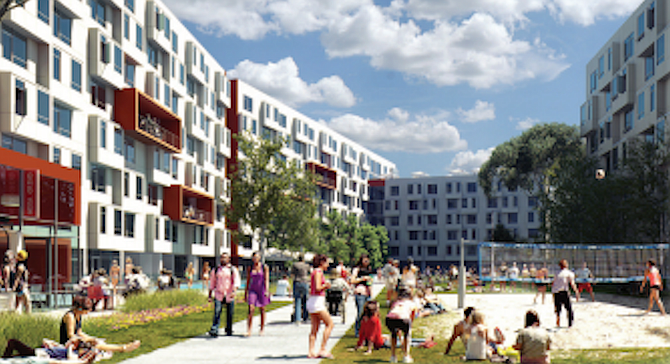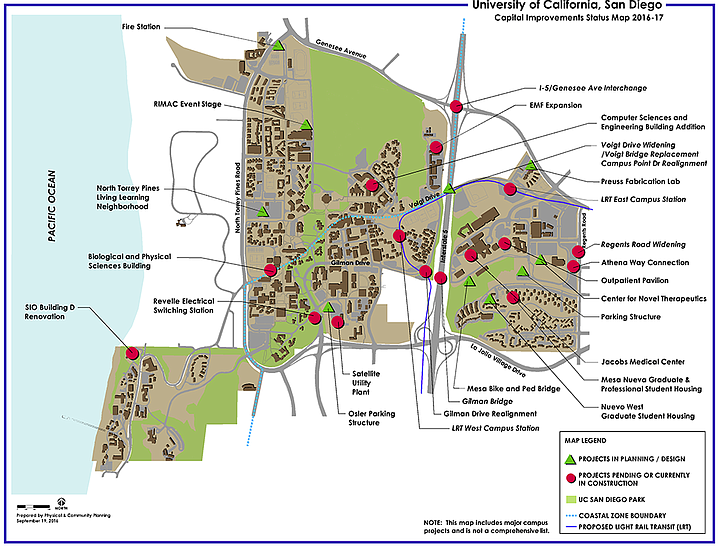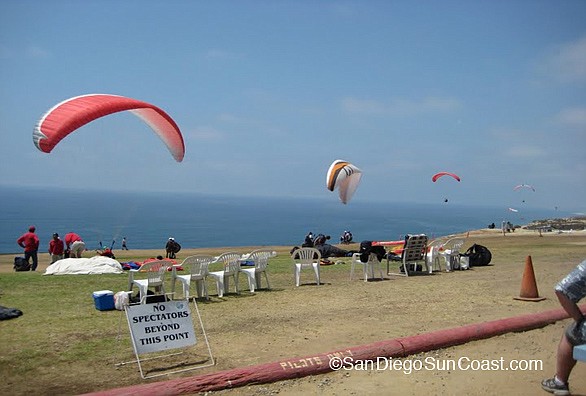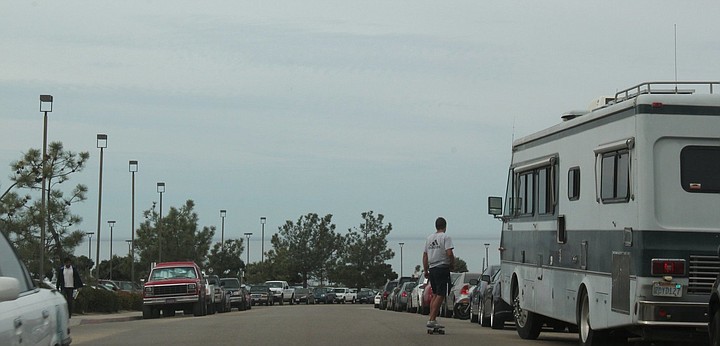 Facebook
Facebook
 X
X
 Instagram
Instagram
 TikTok
TikTok
 Youtube
Youtube

People who live around the UCSD campus — both in University City and in La Jolla — say the coming addition of more than 5,500 dorm beds came as an unpleasant surprise. "They tell you they are putting in a single building and they build the roads to access it, and then they turn around and slam in more tall buildings," said Cameron Volker, a La Jolla resident. "We tried to have a good relationship with them, and they lied flat out about what they were planning."

The campus is building a housing projects at the northwest end of the campus called the Torrey Pines Living and Learning Neighborhood, with 2,000 beds, and 1,250 parking spaces. The east end of campus is slated as the site for three new projects which add a total of more than 3,500 new beds and 2,400 parking spaces. The environmental impact statement for the North Torrey Pines project is now a draft in the comment period, which began on June 2 and ends July 2.

Both neighborhoods say they already are de facto parking lots for students and campus employees who can't or won't pay to park. They point out that if the city regulated campus development, it would require one parking space for each bed. And, they say, the university will add more employees as a result of the 5,500 new resident students — and the new staff will park in their neighborhood

"Traffic, parking, fire protection are all community issues no one at UCSD has to deal with because they are accountable only to the regents," said Janay Kruger, the chairwoman for the University City planning group. "For over 10 years we've been begging for a fire station that we need more with each project."
The university's plans are reviewed only by the state university system and the California Coastal Commission. (Ironically, a fight between La Jollans and the university in the early 1970s appears to be the driving force behind the Coastal Act and the creation of the coastal commission.) "The coastal commission gave them the green light to exceed the coastal zone height limits of 30 feet," Volker said. "They came back with four or five 10-story buildings."
University spokeswoman Judy Piercey said that 80 percent of the campus undergraduates are Californians, many of whom would be unable to pay the high rents near the campus. With the new Mid-Coast Trolley line slated for completion about the same time the housing is built, planners anticipate that students will use mass transit and won't need cars. But neighbors on both sides say that adding students and the staff to support them will simply drive up the numbers of people driving their streets and parking there.
"The campus was supposed to be a maximum of 10,000 people, and they are planning for 45,000" said Joy Urich, who lives in La Jolla. "Now we can look forward to some not particularly interesting buildings that block people's ability to see and feel the ocean.
The projects are in advanced planning stages, with one already under construction. Torrey Pines North, which will cost $627 million, is going to use the Torrey Pines Gliderport for construction equipment and storage. "That's three years of construction and the loss of public access at the glider port," Volker said."Nobody wants the density, nobody wants the traffic and certainly nobody wants three years of construction that change the coastline." The 1,400 bed Nuevo East project, to increase graduate and professional student housing, will cost $252 million and begin construction in 2020.
The Nuevo West grad student project, with 804 beds, will cost $178 million and will break ground in late 2019. And the Mesa Nueva housing slated for graduate students, with 1,350 beds will also cost $178 million. It is under construction now and is expected to be finished by July 2017. The university is already leasing the completed units.
Drafts of the environmental impact reports for the two east campus project not under construction yet are being written and will become available for public comment once they are finished, according to Piercey. She pointed out that the university "has formed a community advisory group so that representatives from the community can engage with campus administration of the 2018 long range development plan.
"They have those meeting so they can say they listened to community input," Urich said. "They don't actually listen."


People who live around the UCSD campus — both in University City and in La Jolla — say the coming addition of more than 5,500 dorm beds came as an unpleasant surprise. "They tell you they are putting in a single building and they build the roads to access it, and then they turn around and slam in more tall buildings," said Cameron Volker, a La Jolla resident. "We tried to have a good relationship with them, and they lied flat out about what they were planning."

The campus is building a housing projects at the northwest end of the campus called the Torrey Pines Living and Learning Neighborhood, with 2,000 beds, and 1,250 parking spaces. The east end of campus is slated as the site for three new projects which add a total of more than 3,500 new beds and 2,400 parking spaces. The environmental impact statement for the North Torrey Pines project is now a draft in the comment period, which began on June 2 and ends July 2.

Both neighborhoods say they already are de facto parking lots for students and campus employees who can't or won't pay to park. They point out that if the city regulated campus development, it would require one parking space for each bed. And, they say, the university will add more employees as a result of the 5,500 new resident students — and the new staff will park in their neighborhood

"Traffic, parking, fire protection are all community issues no one at UCSD has to deal with because they are accountable only to the regents," said Janay Kruger, the chairwoman for the University City planning group. "For over 10 years we've been begging for a fire station that we need more with each project."
The university's plans are reviewed only by the state university system and the California Coastal Commission. (Ironically, a fight between La Jollans and the university in the early 1970s appears to be the driving force behind the Coastal Act and the creation of the coastal commission.) "The coastal commission gave them the green light to exceed the coastal zone height limits of 30 feet," Volker said. "They came back with four or five 10-story buildings."
University spokeswoman Judy Piercey said that 80 percent of the campus undergraduates are Californians, many of whom would be unable to pay the high rents near the campus. With the new Mid-Coast Trolley line slated for completion about the same time the housing is built, planners anticipate that students will use mass transit and won't need cars. But neighbors on both sides say that adding students and the staff to support them will simply drive up the numbers of people driving their streets and parking there.
"The campus was supposed to be a maximum of 10,000 people, and they are planning for 45,000" said Joy Urich, who lives in La Jolla. "Now we can look forward to some not particularly interesting buildings that block people's ability to see and feel the ocean.
The projects are in advanced planning stages, with one already under construction. Torrey Pines North, which will cost $627 million, is going to use the Torrey Pines Gliderport for construction equipment and storage. "That's three years of construction and the loss of public access at the glider port," Volker said."Nobody wants the density, nobody wants the traffic and certainly nobody wants three years of construction that change the coastline." The 1,400 bed Nuevo East project, to increase graduate and professional student housing, will cost $252 million and begin construction in 2020.
The Nuevo West grad student project, with 804 beds, will cost $178 million and will break ground in late 2019. And the Mesa Nueva housing slated for graduate students, with 1,350 beds will also cost $178 million. It is under construction now and is expected to be finished by July 2017. The university is already leasing the completed units.
Drafts of the environmental impact reports for the two east campus project not under construction yet are being written and will become available for public comment once they are finished, according to Piercey. She pointed out that the university "has formed a community advisory group so that representatives from the community can engage with campus administration of the 2018 long range development plan.
"They have those meeting so they can say they listened to community input," Urich said. "They don't actually listen."
Comments